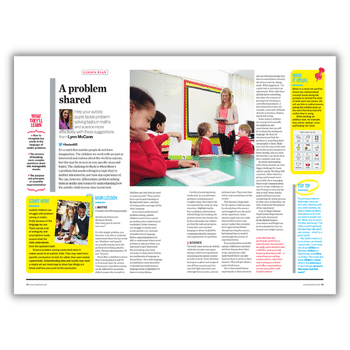Make Sure Your School is Using Teaching Assistants Effectively

With research painting a mixed picture of how effective TAs are in the classroom, schools need to be clear as to what their role should be, says Kate Sarginson…

Teaching Assistants have been a staple in classrooms up and down the country for decades. An extra adult in the classroom, for a fraction of the price of a teacher; a go-to person for helping with displays, trips, exam invigilation, photocopying, lunchtime clubs, playground duty, fetcher of wet paper towels – the list goes on.
The prevailing view in schools seems to be that we’ve become heavily reliant on TAs, without being sure as to how and why. We feel they make a difference, we can’t imagine our schools without them, and they’re probably really nice people to boot, but how certain are we that their presence in the classroom makes a real impact on educational outcomes?
TAs are commonly assigned to support pupils with SEN. Our most complex and vulnerable children and young people are often entrusted to the care of people in this role, with money (chiefly from the Pupil Premium) increasingly being spent on deploying additional TAs, to the point where this spend accounted for around 18% of primary schools’ budgets in 2016/17.
It’s therefore not surprising that at a time of increasing financial constraints, questions are being asked about how effective that spending has actually been.
Regularly reviewing your TA provision and making informed decisions about what it involves is essential for ensuring accountability and checking that your resources are being spent responsibly.
SENCos should engage with the limited, but growing amount of available research on TA effectiveness, and be brave enough to stop automatically repeating the same TA support arrangements from one academic year to the next.
SENCos might have to start thinking differently about the role, challenging assumptions, and being categorically clear when justifying the required spend.
Managing expectations
Digging into a summary of existing research into TA effectiveness by the Education Endowment Foundation, it seems the ways in which TAs are developed and deployed makes a significant difference to how effective they are.
Time therefore needs to be put into unpacking why some TAs are ineffective, and identifying ways of maximising their impact in the classroom.
Individual personalities and competencies aside, there are some contributing factors that could be seen as setting TAs up to fail. TAs are meant to be led and guided by teachers.
So why are trainee teachers not specifically taught in depth about the TA role, and how to utilise and direct TAs during their training? How a TA is deployed should be a crucial element of lesson planning and reflection.
The structure of the school day, combined with the hierarchical nature of education settings, means that pre-lesson communication between teachers and TAs is limited at best, and more likely non-existent.
Without clear knowledge of the teacher’s expectations, many TAs will enter classrooms not knowing what’s going to happen in the lesson, or what the teacher even wants them to do.
TAs will have countless insights, suggestions and questions about the lesson and the pupils they’re working with, yet bizarrely, this level of reflective professional dialogue rarely takes place after lessons. That’s a huge loss to the teaching and learning process; that it isn’t a staple of both roles seems nonsensical.
Teachers first
SENCos should be encouraged by the 2014 SEND Code of Practice, which clearly emphasises the need for quality first teaching and that teachers are responsible for the development and progress of all the students in their class. Pupils with SEN aren’t, and have never been, solely the domain of the TA.
Thought could perhaps be given to an alternative model of in-class support, where TAs can be directed to work with children of a wider range of abilities so that the teacher – the more highly trained specialist – can focus on those children with SEN.
Some parents might benefit from a conversation that reframes the notion of what classroom support for their child should look like. Be careful that parents don’t get the impression that the teacher isn’t able or responsible for meeting the needs of pupils with SEN, and that the TA should be their first port of call.
Parents need to understand that TAs work from the direction of the teacher; it’s the teacher who will ultimately oversee their child’s educational progress, development and well-being.
Research has shown that TAs who are trained to deliver specific programmes and interventions on a one-to-one or small group basis can have a positive impact on pupil achievement.
Yet how often are TAs able to access opportunities for CPD so they can up-skill, learn and diversify? Programme delivery results equate to measurable outcomes that are quantitative, and which can complement the qualitative difference TAs often bring to the table from the close working relationships they have with pupils.
If a wage is being paid, then we need to see positive outcomes. That’s what we expect from teachers – why should it be any different for those in a support role?
Where TAs are deemed to have been ineffective, a number of questions arise. Do TAs feature in the school development plan? Is their role carefully considered as part of a broader strategy, or treated as more of an afterthought by school leaders?
TAs should have competency standards to adhere to, and be recognised as professionals by their colleagues. Is there a formal appraisal structure, where TAs are set targets, and are challenged and supported in their role? Is there any accountability or do they simply turn up, wing it and go home?
Making a difference
There is, however, a complication in that the EEF’s findings seem to contradict LA recommendations. EHCPs often state that TA support is essential for specific pupils, putting SENCOs in something of a quandary – legally obliged to provide TA support, whilst becoming increasingly aware that it may not actually work.
The EEF’s aforementioned Teaching & Learning Toolkit states that TAs are ‘Low impact for high cost, based on limited evidence.’ As a long-serving SENCo, I find this hard to digest.
I’ve previously had the pleasure of working with many TAs over the years, and have seen first-hand the pastoral difference they can make – but it’s not hard to do the maths. The EEF’s conclusions evidently challenge the long-held assumption that TAs are a necessity.
With funding becoming ever more precious, we have an obligation to carefully examine how funds can be allocated to ensure pupils with SEN make progress. Consider the term ‘Teaching Assistant’ – it’s a post whose holders are supposed to assist with the process of teaching. If the business of teaching is learning, pupils have to learn better as the result of a TA’s presence. In turn, schools have to be certain that the individuals employed in these roles are providing value for money and making a tangible difference to pupil outcomes.
TA tips
- Understand that TAs are highly valued by parents, and that any change to provision must be broached sensitively.
- Educate and reassure parents of pupils with SEND that not having a TA constantly at their child’s side can actually be a positive measure.
- Bear in mind that working with TAs isn’t a key part of ITT, and that NQTs might therefore need structured support to maximise their use.
- tress that teachers are responsible for pupils of all ability levels in the classroom – TAs should support learning, not supplement their teaching.
- Time should be set aside for teachers and TAs to engage in joint planning and evaluation, and go about the process of building a professional working relationship.
Kate Sarginson is assistant headteacher at Berwick Middle School, Northumberland and a former SENCo.











